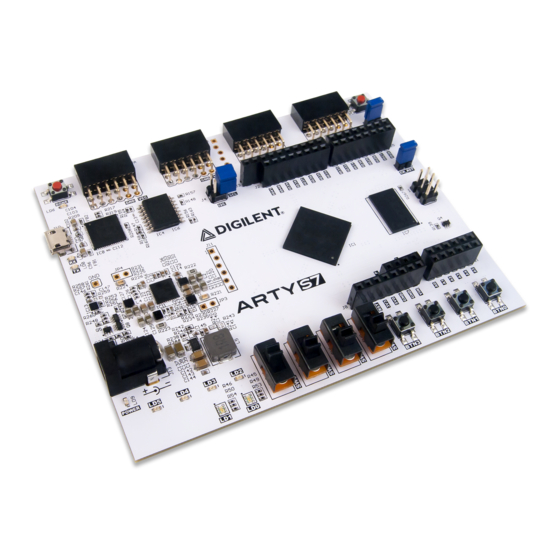Digilent Arty S7 Manual de referência - Página 12
Procurar online ou descarregar pdf Manual de referência para Placa-mãe Digilent Arty S7. Digilent Arty S7 14 páginas.

Pin Name
Shield Function
SDA
I2C Data
IO13
General purpose I/O,
SPI Clock
IO11
General purpose I/O,
SPI Data out
IO12
General purpose I/O,
SPI Data in
IO10
General purpose I/O,
SPI Slave Select
A0-A5
Single-Ended Analog
Input
A6-A9
Differential Analog
Input
V_P, V_N
Dedicated Differential
Analog Input
XGND
XADC Analog Ground
XVREF
XADC Analog Voltage
Reference
Not Connected
N / C
IOREF
Digital I/O Voltage
reference
RST
Reset to Shield
3V3
3.3V Power Rail
5V0
5.0V Power Rail
GND (), G
Ground
VIN
Power Input
Table 9.1. Arty S7 Shield Pinout
9.1 Shield Digital I/O
The pins connected directly to the FPGA can be used as general purpose inputs or outputs. These pins include the I2C, SPI, and general purpose I/O pins. There are 200 Ohm series
resistors between the FPGA and the digital I/O pins to help provide protection against accidental short circuits (pins A10 and A11 instead have 140 Ohm series resistors). The
absolute maximum and recommended operating voltages for these pins are outlined in Table 9.1.1.
Absolute Minimum
Voltage
Powered
-0.4 V
Unpowered
-0.4 V
Table 9.1.1. Shield Voltage Specifications
For more information on the electrical characteristics of the pins connected to the FPGA, please see the
(https://www.xilinx.com/support/documentation/data_sheets/ds189-spartan-7-data-sheet.pdf)
The pins on the shield connector typically used for I2C signals are labeled as SCL and SDA. When using these signals to implement an I2C bus it is necessary to attach a pull-up
resistor to them. On the Arty S7, this can be done by placing two shorting blocks horizontally across the J4 header.
9.2 Shield Analog I/O
The pins labeled A0-A9 and V_P/V_N are used as analog inputs to the XADC module of the FPGA. The FPGA expects that the inputs range from 0-1 V. On the pins labeled A0-A5
we use an external circuit to scale down the input voltage from 3.3V. This circuit is shown in Figure 9.2.1. This circuit allows the XADC module to accurately measure any voltage
between 0V and 3.3V (relative to the Arty S7's GND ()) that is applied to any of these pins. If you wish to use the pins labeled A0-A5 as Digital inputs or outputs, they are also
connected directly to the FPGA before the resistor divider circuit (also shown in Figure 9.2.1).
Arty S7 Connection
See Section titled "Shield Digital I/O"
See Section titled "Shield Digital I/O"
See Section titled "Shield Digital I/O"
See Section titled "Shield Digital I/O"
See Section titled "Shield Digital I/O"
See Section titled "Shield Analog I/O"
See Section titled "Shield Analog I/O"
See Section titled "Shield Analog I/O"
Connected to net used to drive the XADC ground reference on the FPGA (VREFN)
Connected to 1.25 V, 25mA rail used to drive the XADC voltage reference on the FPGA (VREFP)
Not Connected
Connected to the Arty S7 3.3V Power Rail (See the "Power Supplies" section)
Connected to the red "RESET" button and a Digital I/O of the FPGA. When JP2 is shorted, it is also
connected to the DTR signal of the FTDI USB-UART bridge.
Connected to the Arty S7 3.3V Power Rail (See the "Power Supplies" section)
Connected to the Arty S7 5.0V Power Rail (See the "Power Supplies" section)
Connected to the Ground plane of Arty S7
Connected in parallel with the external power supply connector (J12). See the "Power Supplies" section for
information on powering the Arty S7 from this pin.
Recommended Minimum Operating
Voltage
-0.2 V
N/A
Recommended Maximum Operating
Voltage
3.4 V
N/A
Spartan-7 datasheet
from Xilinx.
Shared
Connections
–
SCLK () pin of SPI
Connector
MOSI () pin of SPI
Connector
MISO () pin of SPI
Connector
SS pin of SPI
Connector
–
–
–
–
–
–
–
–
–
–
–
–
Absolute Maximum
Voltage
3.75 V
0.55 V
